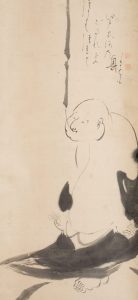Painting and calligraphy by Zen monks has a long history in Japan. Introduced from China in the twelfth century, Zen (meaning “meditation”) has its origins in the teachings of the Buddha, the sixth-century BCE Indian prince who taught that it was possible to be freed from human suffering. However, it is the legendary Indian monk Bodhidharma (called Daruma in Japan) who is considered the founder and First Patriarch of Zen. Rejecting the study of texts and established rituals in favor of strict meditative practice, Daruma achieved enlightenment. Subsequently, he accepted a disciple, whose enlightenment experience Daruma verified, thus beginning the mind-to-mind transmission of enlightenment and of the teacher-disciple lineages that continue to this day.
With the establishment of the Tokugawa shogunate in the early seventeenth century, over two centuries of governmental sponsorship of Zen institutions and artistic patronage ended. Despite the loss of governmental support, Zen still thrived, as monks and abbots reformed monastic practices and sought new means to reach out to adherents from all social and economic classes. Zen art likewise flourished. Zen masters freely explored opportunities to create more personal and directed work that expressed their own experiences, educated young monastics, and encouraged lay followers. This art form—the visual expression of the Zen master’s mind—has come to be known as “Zenga.”
The paintings and works of calligraphy that comprise the exhibition Teaching Beyond Doctrine: Painting and Calligraphy by Zen Masters, on view in NOMA’s Japanese galleries through January 20, 2019, were created primarily during the Edo period (1615-1868). The most influential of these Zen masters, Hakuin Ekaku (1686–1769), is credited with creating a new visual language for Zen, by dramatically expanding its subjects and themes to include Shinto gods, Confucian maxims, Japanese legend, folklore, and scenes from everyday life. Hakuin’s immediate followers, along with later generations of Zen masters, have drawn on this rich pictorial vocabulary to the present day.

Hakuin Ekaku (Japanese, 1686–1768), Hotei in the Guise of a Street Performer, mid-18th c., Ink on paper, Museum purchase: Asian Art De-Accession Fund, 2018.14
Zen history and culture are embedded in these works. Each was created by an enlightened master using the simple materials of brush, ink and paper, providing a direct encounter with the Zen master’s mind in order to advance the spiritual journey of the viewer. Drawn from NOMA’s permanent collection, and highlighting several recent acquisitions, the exhibition has benefited from generous loans from the Gitter-Yelen Foundation. We are also grateful to John Stevens, Jonathan Chaves, Stephen Addiss, and Audrey Yoshiko Seo, who read and translated many of the inscriptions.
—Lisa Rotondo-McCord, Deputy Director for Curatorial Affairs | Curator of Asian Art